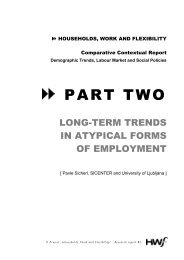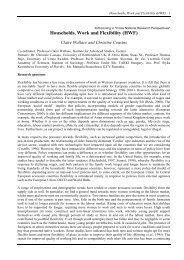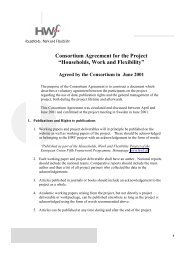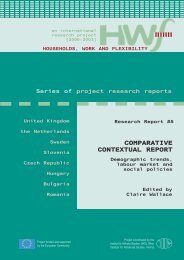Guidelines for Analysis of Surveys - HWF
Guidelines for Analysis of Surveys - HWF
Guidelines for Analysis of Surveys - HWF
You also want an ePaper? Increase the reach of your titles
YUMPU automatically turns print PDFs into web optimized ePapers that Google loves.
<strong>Guidelines</strong> <strong>for</strong> <strong>Analysis</strong> <strong>of</strong> <strong>Surveys</strong><br />
13.07.2001<br />
General Remarks<br />
We propose that there should be two parts to the analysis <strong>for</strong> each country.<br />
Part 1 should be <strong>of</strong> standardised <strong>for</strong>mat<br />
Part 2 should be according to the interests <strong>of</strong> the team and is open.<br />
In this document we shall prepare guidelines <strong>for</strong> Part 1 <strong>of</strong> the survey.<br />
In the end we need a common definition <strong>of</strong> flexibility <strong>of</strong> time, place and conditions<br />
but first it needs to be analysed at a national level. At the meeting in Vienna in<br />
November 2002 we will discuss how to measure flexibility, but we need to begin with<br />
the picture <strong>for</strong> each country and build up from there.<br />
The analysis does not need to be limited only to survey data. Other data sources (e.g.<br />
time budget data) could also be included.<br />
Each partner needs to prepare a short summary <strong>of</strong> what were the optional questions<br />
and how the survey was adapted (e.g. <strong>for</strong> a telephone interview) as part <strong>of</strong> their<br />
documentation.
<strong>HWF</strong> <strong>Guidelines</strong> <strong>for</strong> national Survey Reports 2<br />
Headings <strong>for</strong> <strong>Analysis</strong><br />
1. Patterns <strong>of</strong> time flexibility<br />
Different hours <strong>of</strong> work according to sex, age and social group (social class but also<br />
urban/rural) and economic standard <strong>of</strong> the household overall (which would need to be<br />
calculated in each country) and the economic level <strong>of</strong> the individual.<br />
Each country needs to define what they mean by flexibility and how it was defined in<br />
the data set.<br />
(1.10-1.19, Grid 1)<br />
2. Patterns <strong>of</strong> place flexibility<br />
Different places <strong>of</strong> work according to sex, age and social group (social class but also<br />
urban/rural) and economic standard <strong>of</strong> the household overall and the economic level<br />
<strong>of</strong> the individual.<br />
(1.20-1.24, Grid 1)<br />
3. Patterns <strong>of</strong> flexibility <strong>of</strong> conditions<br />
Different condition <strong>of</strong> work according to sex, age and social group (social class but<br />
also urban/rural) and economic standard <strong>of</strong> the household overall and the economic<br />
level <strong>of</strong> the individual.<br />
(1.25-1.29, Grid 1)<br />
4. Patterns <strong>of</strong> career flexibility<br />
How flexible are respondents across their careers? According to age, social class,<br />
education and economic standard <strong>of</strong> the household overall and the economic level <strong>of</strong><br />
the individual.<br />
(4.3-4.5)<br />
5. The Accumulation <strong>of</strong> different kinds <strong>of</strong> work<br />
How individuals put together a range <strong>of</strong> different kinds <strong>of</strong> work according to sex, age,<br />
social group and economic standard <strong>of</strong> the household and the individual<br />
(1.5,1.6,1.7,Grid 1)<br />
6. Perceptions <strong>of</strong> flexibility<br />
According to sex, age and social group and economic standard <strong>of</strong> the household and<br />
individual<br />
(4.1-4.2)<br />
7. Integration <strong>of</strong> home and work<br />
Different patterns <strong>of</strong> family and work according to age, social group, household<br />
membership. (Perhaps create typologies <strong>of</strong> family and work).<br />
(Grid 2,Grid 3)
<strong>HWF</strong> <strong>Guidelines</strong> <strong>for</strong> national Survey Reports 3<br />
8. Employment and child care arrangements<br />
Taking into account the whole pattern <strong>of</strong> work in the household as well as that <strong>of</strong> just<br />
the individual (Grid 2, Grid 3 and Grid 4) and according to social class, age and<br />
economic standard.<br />
9. Domestic roles and employment roles<br />
The ways in which different patterns <strong>of</strong> domestic roles are organised and how this fits<br />
with patterns <strong>of</strong> work (Grid 4, Grid 1, Grid 2). Also with the family-work typology<br />
and with economic standards.<br />
10. Perceptions <strong>of</strong> family/work arrangements<br />
According to sex, age and social group but also according to household-work<br />
typology (see above) and with economic standards.<br />
11. Patterns In<strong>for</strong>mal and voluntary work<br />
According to sex, age and social group and how this fits with the family-work<br />
typology (see above) and with economic standards<br />
12. Patterns <strong>of</strong> decision making in the household<br />
According to age and social group. How this fits with the family-work typology and<br />
with economic standards<br />
Main independent variables:<br />
• Age <strong>of</strong> respondent<br />
• Sex <strong>of</strong> respondent<br />
• Social group <strong>of</strong> respondent (derived from ISCO codes)<br />
• Urban/rural situation<br />
• Economic condition <strong>of</strong> the household<br />
• Economic standard <strong>of</strong> the individual<br />
• Family-Work typology (how should this be constructed?)<br />
• Size and composition <strong>of</strong> the household.









